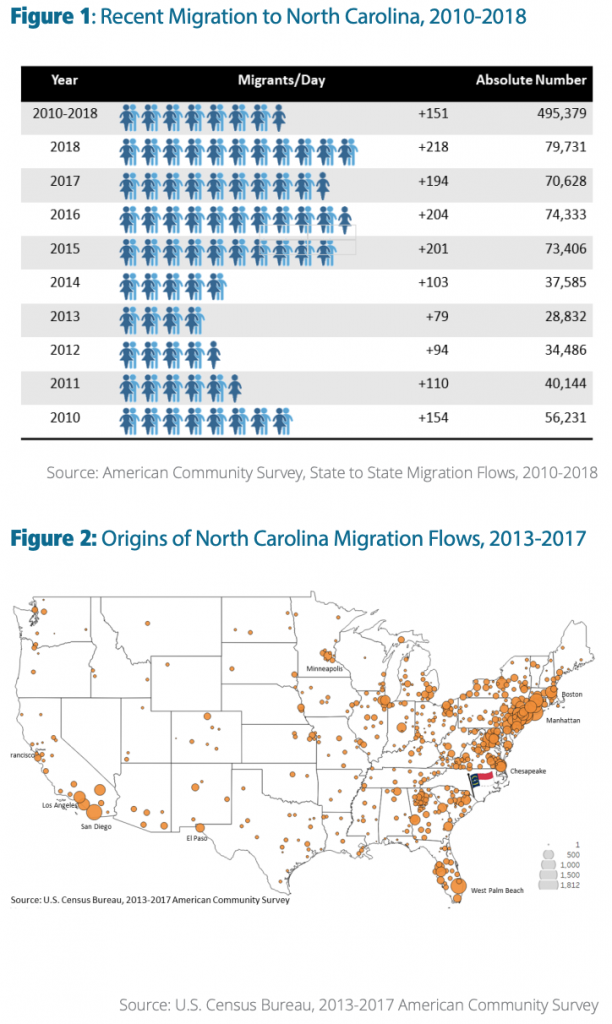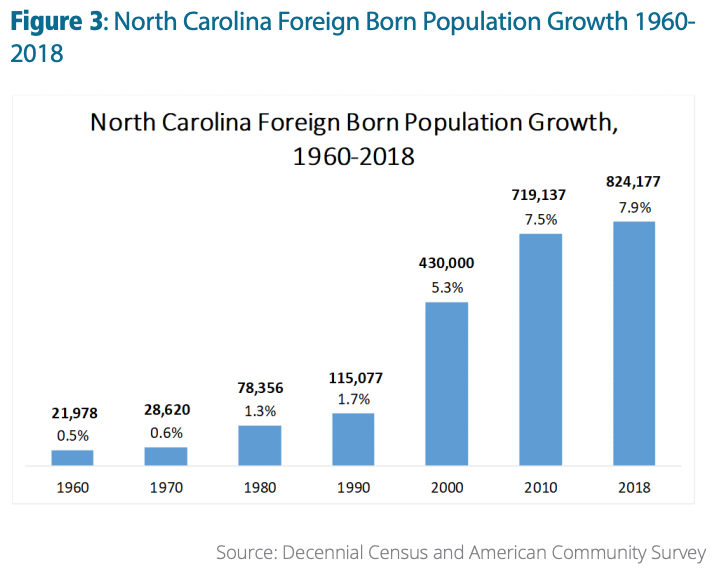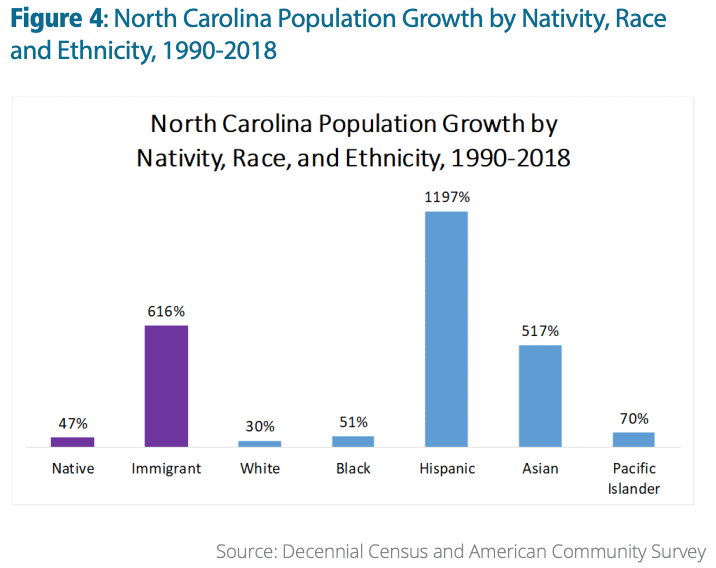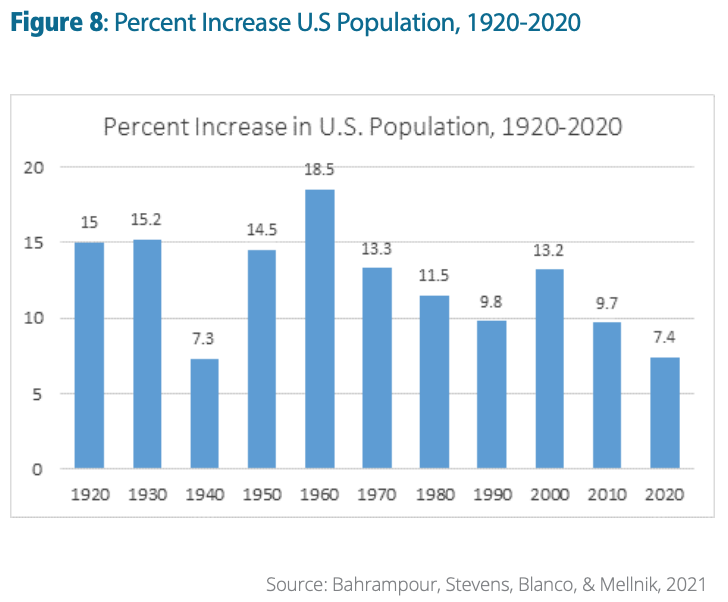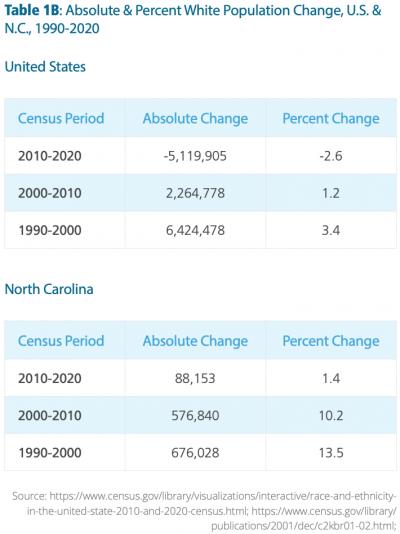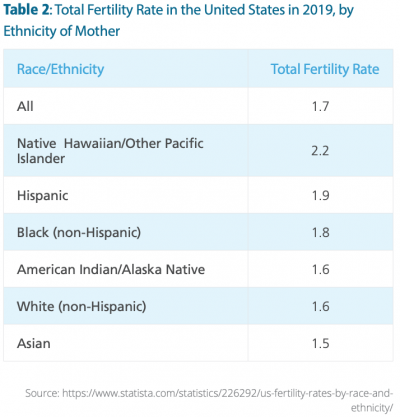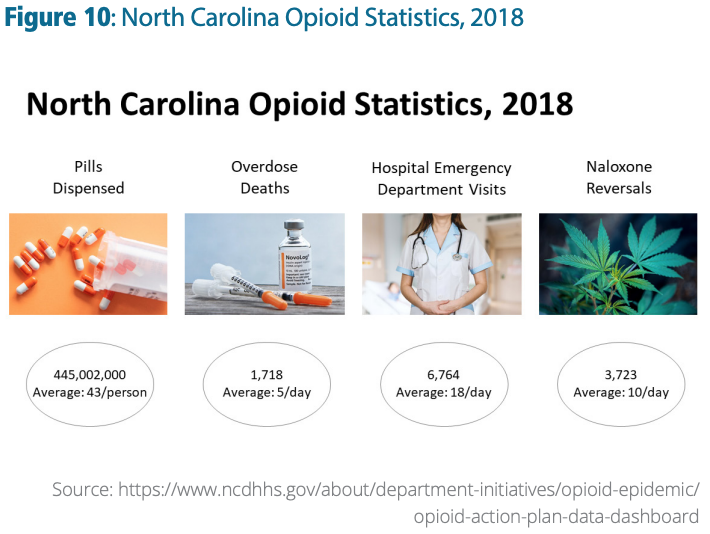Real Estate Alert! Gale Force Demographic Wind Gusts Ahead
Newcomers from other states and abroad are principally responsible for North Carolina’s population boom–growth by 3.9 million– since 1990. However, seven powerful demographic disruptors—analogous to gale force wind gusts in an adverse weather event—can potentially quell future growth and demand for residential and commercial real estate. Strategies to circumnavigate the adverse effects of the demographic gale force winds ahead are discussed.
White Paper by James H. Johnson Jr., Ph.D
Kenan-Flagler Business School UNC-Chapel Hill
October 2021
Home | Publications | Real Estate Alert! Gale Force Demographic Wind Gusts Ahead
ABSTRACT
Newcomers from other states and abroad are principally responsible for North Carolina’s population boom–growth by 3.9 million– since 1990. However, seven powerful demographic disruptors—analogous to gale force wind gusts in an adverse weather event—can potentially quell future growth and demand for residential and commercial real estate. Strategies to circumnavigate the adverse effects of the demographic gale force winds ahead are discussed.
Introduction
North Carolina has been a major migration magnet—and by extension, one of the nation’s most rapidly growing states over the past three decades, adding 3.9 million people since 1990. The state’s population boom has afforded the real estate industry enormous opportunities to create residential communities and commercial properties that align with the lifestyles and consumer preferences of individuals and families coming to live, work, play, and do business in our state. However, seven powerful demographic disruptors—analogous to gale force wind gusts in an adverse weather event—can potentially stymie future population growth and demand for all types of real estate in the years ahead.
This article provides a general overview of the population boom and delves into the details of the seven demographic gale force winds that our nation and this state will face. It concludes with the likely consequences of failing to address these demographic disruptors and outlines the policy domains that require lobbying investments to mitigate the potentially adverse effects of impending demographic shifts on real estate markets.
The State’s Population Boom
Over the past three decades, North Carolina has been “all that and a bag of chips plus dip” demographically. That is, it has been one of the nation’s most attractive and dynamic centers of population growth—in the South and nationally.
Demonstrative of the state’s attractiveness, newcomers —an average net influx of 151 per day—arrived from small, medium, and large sized communities (Figure 1) in just about every other state in the nation between 2010 and 2018 (see Figure 2). And most recently, in the early months of the COVID-19 outbreak, the state experienced a significant influx of pandemic refugees fleeing the nation’s major urban centers. Commenting on the influx of pandemic refugees in one western North Carolina community, a local official said,
WE HAD…ONE BILLION DOLLARS IN RESIDENTIAL REAL ESTATE SALES IN THE HIGH-COUNTRY REGION FOR THE YEAR 2020…WITH PEOPLE FLEEING THE CITY, EVERY HOUSE THAT’S FOR SALE [IN THIS COMMUNITY] IS GONE. THEY’RE [OUTSIDERS] ARE BUYING THESE HOUSES SIGHT UNSEEN; THEY’RE COMING HERE. THEY DON’T EVEN GO IN THE HOME; THEY’RE BUYING THEM ONLINE, AND THEY’RE FLEEING THE CITY. I’VE GOT PEOPLE FROM NEW YORK, PENNSYLVANIA, TENNESSEE, AND FLORIDA. THEY’RE ALL COMING HERE.
Elaborating further on the influx of pandemic refugees, this local community leader went on to state,
WHAT I’VE SEEN…OUR POPULATION CHANGED. WE’RE A POPULATION OF 17,800 PEOPLE…BUT…WE’RE EIGHT GOLF COURSES AND TWO SKI RESORTS. SO, ALL THESE PEOPLE THAT ARE NORMALLY NOT HERE CHOSE TO FLEE THE CITY AND COME TO THEIR HOMES IN THE MOUNTAINS [DURING THE PANDEMIC]. SO, OUT POPULATION IS PROBABLY 27,000 PEOPLE.
Beyond attracting interstate movers (including pandemic refugees), North Carolina also has emerged as a prime destination for movers from abroad, mainly from countries in Latin America and Asia. In 2018, North Carolina’s immigrant population was enumerated at slightly over 824,000, representing a 616% (709,000) increase over the state’s foreign-born population in 1990 (115,000) (see Figure 3).
Newcomers entering the state through these diverse migration streams have dramatically transformed the composition and complexion of the state’s population. Outpacing both white and black growth, Hispanic and Asian newcomers particularly have diversified the race/ ethnic mix of the population (see Figure 4). Reflecting an ongoing process popularly referred to as the “browning” of the Tar Heel state, these two groups along with other people of color, including most notably Native Americans, Blacks, and mixed-race individuals, have accounted for ninety percent of the state’s net population growth since 2010.
Newcomers also have diversified the state socioeconomically. On average, recent in-migrants have higher incomes than both outmigrants (people who left the state) and non-migrants (long term residents of the state) (see Figure 5). Consequently, newcomers have created a migration dividend for the state by increasing aggregate consumer purchasing power and boosting business and tax revenues.
While in-migrants across the age spectrum have higher per-capita adjusted gross incomes than both out-migrants and non-migrants, newcomers 55 and older—many of whom are retirees contributing to the “graying” of The Old North State–are generating the largest migration dividend (Figure 5). In 2017-18 (latest statistics available), according to Internal Revenue Service data on interstate movers, the per-capita adjusted gross income of the typical newcomer Boomer household ($63,546) was $7,000 higher than the per-capita adjusted gross income of the typical outmigrant Boomer household ($56,968) and $15,000 higher than the per capita adjusted gross income of the typical nonmigrant Boomer household ($48,251).
Winners & Losers
Unfortunately, there are demographic winners and losers in the state’s population boom apparent when looking across the state’s 100 counties. Over the past three decades, growth has been highly concentrated in a few counties (see Figure 6). Between 2010 and 2020, for example, 47 percent of net growth was concentrated in two counties, 64 percent in five counties, 84 percent in 10 counties, and 95 percent in 15 counties. Most of these counties are urban in character and/or rich in natural and cultural amenities—attractive places for newcomers with higher incomes and more diverse life-style preferences.
For the long-term residents of these rapidly growing migration magnet counties, however, the wealthier newcomers have driven up the cost of housing and other goods and services. Reflecting on the influx of pandemic refugees into the high country region of the state, the previously referenced local officials said,
THERE’S NO AFFORDABLE HOUSING. THAT WAS A PROBLEM BEFORE THE PANDEMIC, NOT IT’S A REAL PROBLEM.
In some instances, the accelerated cost of living has priced the working poor, seniors on fixed incomes, and some civil servants (i.e., police officers, fire personnel, EMS workers, and public chool teachers, among others) out of these markets. It has forced some into homelessness and others to move to more affordable communities requiring longer and more costly work commutes to jobs in these rapidly growing communities.
Popularly referred to as gentrification, this wealthier newcomer-induced dislocation of long -term residents— an unintended consequence of the population boom– has generated demands for more equitable and inclusive community economic development policies and practices in these migration magnet counties. More affordable workforce housing, workforce development policies that eliminate barriers to economic participation, and more inclusive contracting and procurement practices from local government and anchor employers are among the “equity tools” proposed to ensure that all residents share in the benefits of the population boom.
At the other end of the geographic spectrum, most of the state’s counties—more than three-quarters—have experienced slow growth, no growth, or decline during the recent population boom. In response to the lack of advanced educational and employment opportunities, most of the young people have left these counties, leaving behind a mostly older adult population that is disproportionately female because men die younger at all ages and especially in the advanced stages of life.
With too few working age, tax-paying adults to support the elderly population, these counites have an old age dependency problem. Hospitals are closing or risk closing. There are not enough senior care facilities to accommodate demand, and patients with serious ailments must travel long distances for health care. Moreover, it is a major challenge for health care facilities in these communities to recruit and retain health professionals. And leveraging tele-health services is difficult, if not impossible, due to a lack of access to broadband bandwidth sufficient to support the service. Indicative of the scope of the problem, as Figure 7 shows, deaths exceeded births in sixty-five of the state’s mostly rural counties in 2019.
Strategies are urgently needed to reduce the outflow of existing residents, to attract new talent, and to ensure adequate access to essential services like health care for the existing residents of these declining counties. In addition to one or more physical ailments, many older adults in these counties suffer from loneliness and isolation–health wise the equivalent of smoking fifteen cigarettes a day.
Gale Force Demographic Wind Gust
Economic and residential dislocations of long term residents in growing urban counties and increasing social and spatial isolation of older adults in declining rural counties are precursors of a set of national demographic gale forces winds that will further shape or influence the state’s population—and by extension real estate markets– in the coming decades. Four of the gale force demographic disruptors—slowing total and foreign population growth, white population loss, and declining fertility—evolved over recent decades. Three—deaths of despair, involuntary retirements, and the declining female workforce—stem from recent crises.
After peaking in 1960, the U.S. population has grown relatively more slowly in every decade over the past 60 years (see Figure 8). In the most recent decade, the population registered the slowest rate of growth (7.4%) since the 1930s (7.3%) and reportedly “the second slowest rate of expansion since the government began taking a census in 1790.” In absolute numbers, the U.S. population growth peaked in 1990 (32.7 million) and has decreased in every decade since, increasing by 22.7 million between 2010 and 2020 (see Table 1A).
Paralleling the national trend and masked in aggregate growth statistics, North Carolina’s population has grown progressively more slowly in each of the past three decades. The state’s population grew by 21.4% in the 1990s, by 18.5% in the 2000s, but only 9.5% between 2010 and 2020. In the most recent decade, North Carolina’s absolute population growth failed to surpass one million for the first time since the 1990s (Table 1A).
Undergirding and principally driving slowing total growth is profound change in the U.S. white population (see Table 1B). After increasing by 12% during the 1990s, the white population increased by only 1.2% during the 2000s. And notably, according to recently released 2020 census statistics, the nation’s white population declined for the first time in history—by 5.1 million or 2.4%–between 2010 and 2020.
In North Carolina the white population continues to grow. However, it has grown progressively more slowly over the past three decades, increasing by 13.5% in the 1990s,10.2% in the 2000s, and by only 1.4 % in the most recent decade (Table 1B).
Declining fertility partially explains revealed white population losses—and by extension slowing total growth. White women’s fertility has been below the replacement level (2.1 births per woman) for more than two decades and population aging reduced the proportion of white women in the key childbearing ages (15 to 44) from 41% in 2000 to 35% in 2019. Moreover, an increasing number of white women between the ages of 40 and 44 have opted not to have children. Mostly well-educated and career oriented, these women are voluntarily childless.
In part for these reasons, deaths outnumbered births among whites nationally for the first time in U.S. history in 2016. And by 2018, deaths exceeded births among whites in more than half of the nation’s 50 states. Deaths have exceeded births among whites in North Carolina since 2015. In the first six months of 2020, there were 12,639 more deaths (51,224) than births (38,585) among whites in the state. Symbolizing the geographic scope of the problem, deaths exceeded births among whites in 87 of the state’s 100 counties in 2019. Only thirteen counties—mainly the amenity rich migration magnets–experienced natural white population increases, that is, more births than deaths (see Figure 9).
Further suppressing total population growth in the U.S. and North Carolina, women of color also are having fewer children. In 2019, for example, Native Hawaiian and other Pacific Islander women were the only group in the U.S. with above-replacement-level fertility (see Table 2).
Notably, foreign born population growth has correspondingly slowed over the past three decades as well, paralleling and contributing to the slowdown in total growth. The slowdown in foreign born population growth—from 57% in the 1990s, to 24% in the 2000s, and to 14% between 2010 and 2019–was driven in part by policies sharply reducing immigration to the U.S., the 2008-10 Great Recession, and the COVID-19 pandemic that literally shutdown U.S. borders to foreigners. Aligned with national trends, a similar pattern of slowing foreign-born population growth was observed in North Carolina (see Table 3).
Deaths of despair–loss of life by drug overdoses, suicides, and diseases such as cirrhosis, liver cancer, and most recently COVID-19 –are further slowing population growth. CDC data reveal there were 90,000 drug overdose deaths in 2020, representing a 30% increase over the 2019 death toll, and bringing the total to more than 900,000 overdose deaths since the U.S. drug epidemic began in the late 1990s.
According to the North Carolina of Department of Health and Human Services, 445 million opioid pills—an average of 43/person–were dispensed in the state in 2018. Paralleling national trends, the impact of opioids on individuals, families, and communities in our state has been devastating. In 2018, there were 1,718 overdose deaths, an average of five per day. Opioid-related hospital emergency department visits totaled 6,764, roughly 18 per day. And there were 3,723 naloxone reversals, roughly ten per day (see Figure 10).
Moreover, and additional evidence of the critical role that declining fertility is playing in the progressively slowing of U.S. total population growth, the U.S. birth rate, contrary to what one might expect during an economic shutdown, dropped by 4% during the pandemic. CDC and National Center for Health Statistics data “confirm…nearly 40,000 “missing births” in the final month and a half of 2020, which otherwise would have been conceived in the early months of the COVID-19 pandemic”. Other estimates suggest there will be “close to 300,000 fewer births in the U.S. in 2021 as a result of the outbreak” (see Figure 11).
In addition, nationally and in North Carolina, COVID-19 reportedly has forced an estimated 1.7 million older workers into involuntary retirement and more than 2 million women out of the workplace. Black workers without a college degree reportedly were more likely than other groups to retire involuntarily during the pandemic. And faced with a dwindling supply of accessible and affordable childcare, working mothers have been forced, as schools transitioned to online learning, to stay home and take care of their children.
Circumnavigating the Impending Demographic Storm
Individually and collectively, these demographic gales will profoundly impact the size and composition of the U.S. workforce in the years ahead. Current worker shortages as the nation attempts to rebound from the pandemicinduced economic recession represent the outer bands of the impending demographic storm.
For the real estate industry, filling vacancies created by the ongoing wave of Boomer retirements combined with the growing demand for more diverse talent within the sector may prove to be a major challenge, not to mention existing labor shortages in the construction trades which also will likely worsen. The demographic gale force winds also will affect consumer markets for goods and services, including the demand for all types of residential and commercial real estate.
To address these demographic gales, real estate industry leaders must audit their own enterprises to ensure they are inclusive and equitable places to work. Having reputational equity—a demonstrated commitment to diversity and inclusion–will be the key to successfully recruiting and retaining diverse talent—a necessary ingredient for accessing and serving diverse markets in the foreseeable future.
Real estate industry executives also must advocate for policies that:
- Reform immigration laws in ways that reflect the critical role that immigrants must play in our economy and society more generally moving forward given slowing total population growth, white population losses, declining fertility, aging, and crisis-induced premature deaths of prime-working age individuals.
- Encourage family-friendly business policies that support women having children and allow them the flexibility to provide and care for their offspring. Women—as both employees and leaders—are key to the future viability of U.S. business enterprises.
- Attack the childcare crisis head on by seeding the nation’s expansive childcare deserts with accessible, high quality, and affordable day care and equipping facility owners and operators with strong business acumen. As one childcare advocate cogently stated, “We know it’s critical for working parents and our economy. We cannot recover from this pandemic in a recession until we have a stable childcare system that parents can rely on so they can return to work.”
- Direct resources to address the social determinants of health that serve as the root cause of deaths of despair and the racially disparate impact of the COVID-19 pandemic. Prioritize access to health care and affordable housing in safe and healthy neighborhood environments. We can no longer afford to continue to lose members of the prime-working age demographic to premature deaths. They make up the next generation of talent that must propel our nation in the hyper-competitive global economy.
- Create encore entrepreneurship and workforce development training programs that provide pathways of re-entry into the post-pandemic economy for the 55+ population of involuntary retirees. Given businesses’ current struggles to fill job vacancies, targeted strategies to recruit this demographic are urgently needed. Bringing involuntary retirees back into the workforce in encore careers will constitute a win-win: employers will gain access to a generation of Boomer workers with a demonstrated strong work ethic and the involuntary retirees will gain access to new income streams that reduce the likelihood living the balance of their lives in poverty.
Successful advocacy will serve as a hedge against the demographic gale force winds confronting our state and nation. It also will ensure the real estate industry has access to the diverse talent and markets required to survive, thrive, and prosper in an ever-changing global marketplace.
About the Author
James H. Johnson, Jr. is the William Rand Kenan, Jr. Distinguished Professor of Strategy and Entrepreneurship in the Kenan-Flagler Business School and Director of the Urban Investment Strategies Center in the Frank Hawkins Kenan Institute of Private Enterprise at UNC-Chapel Hill.
The Kenan Institute serves as a national center for scholarly research, joint exploration of issues, and course development with the principal theme of preservation, encouragement, and understanding of private enterprise.
Related Articles
Is North Carolina’s Attractiveness as a Migration Destination Waning?
Is North Carolina’s Attractiveness as a Migration Destination Waning?We are witnessing a re-balancing after the COVID migration surge or a fundamental shift in North Carolina’s attractiveness as a domestic and international migration magnet.White Paper by James H....
North Carolina at a Demographic Crossroad: Loss of Lives and the Impact
North Carolina at a Demographic Crossroad:Loss of Lives and the ImpactNorth Carolina’s phenomenal migration-driven population growth masks a troubling trend: high rates of death and dying prematurely which, left unchecked, can potentially derail the state’s economic...
WILL HURRICANE IAN TRIGGER CLIMATE REFUGEE MIGRATION FROM FLORIDA
Will Hurricane Ian Trigger Climate Refugee Migration from Florida?Thirteen of Florida’s counties were declared eligible for federal disaster relief following Hurricane Ian’s disastrous trek through the state (The White House, 2022). The human toll and economic impact...






